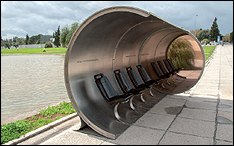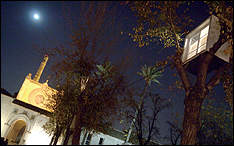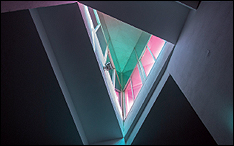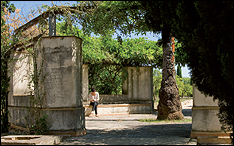![]()
OUTDOOR WORKS
on the Grounds of the
CAAC

 |
 |
 |
 |
 |
 |
 |
 |
 |
 |
 |
 |
 |
 |
 |
|
Date: From June
21 2013
|
|
|
Colour photograph printed on adhesive vinyl
A professional advertising billboard installed at the Centro Andaluz de Arte Contemporáneo, opposite the headquarters of the Seville Council City Planning Commission, displays a large-format photograph of an architectural object found in a place that might be anywhere. The image is part of a sequence of photographs inspired by the "pre-ruin" concept, in which Jorge Yeregui (Santander, 1975) documents unfinished, abandoned buildings that are moulded by the forces of time and nature. Aside from general musings on what was or might have been, this image forces us to meditate on the fracture that resulted in its loss of purpose, turning the structure into a contradictory element that colonizes the territory yet remains bleakly uninhabitable. These anonymous, unproductive remains are minor landmarks whose denuded presence has a raw, unpolished quality that underscores their resemblance to sculpture. Just as billboards draw the attention of the public-cum-consumers to the products they advertise, so the act of decontextualizing this architecture and transferring it to the realm of the image accentuates the strangeness and unfamiliarity of an increasingly ubiquitous landscape. [BACK] |
|
|
Installation. Painted marble fragments Ever since creating her first pieces in Los Angeles in the 1970s, artist Maura Sheehan has striven to give the spaces she works in new meanings by examining their economic, political and social context and how this context has influenced architectural forms. Lagunas (2000) was part of a series of five interventions grouped under the title Veladuras [Glazes] that the artist produced at the CAAC in the year 2000. In this work, consisting of a geometric arrangement of pieces of marble discarded during roofing renovations on a CAAC building, Sheehan brings the concepts of both ruin and colour into play. The idea of ruin is tied to the abandonment and deterioration of the Island of La Cartuja after it hosted Expo '92 Seville. And the colour is the same bold blue found on the ceramic ornaments that grace the facade of the former monastery - a hue used in many Mediterranean countries to paint terraces, balconies and walls - reminding us that this building was once an Almohad pottery. Thus, building and facade provide us with the clues to interpreting Lagunas, a collaborative effort in which architecture, history and vision converge. [BACK] |
|
|
Installation. Polished stainless steel, neon and
glass 212 x 359.5 x 210 cm Pedro de Mora (Seville, 1961) is able to derive sustenance from the societies he inhabits and develop his language around them. His work moves rapidly from one theme to the next, creating an oeuvre that defies classification. However, on this fast-paced journey he never sacrifices the visual component of his ideas, maintaining a clearly defined style. In Bus Stop, the artist attempts to cross the dividing line between art and the everyday by removing his work from the restricted space of the museum and taking it into the public urban arena. In doing so, he inverts Duchamp's strategy of bringing objects into the museum that seemingly have no place there. Mora divests the museum of art, reinserting it in a living fabric of ordinary experiences in order to develop a 21st-century aesthetic in the sphere of the civic and the everyday. This work alters the traditional concept of the monument; by using premium materials typically reserved for sculptures, the artist has created a singular prototype of street furniture that can be used as a place of social relaxation or interaction, making users an active part of the sculpture. [BACK] |
|
|
Steel, paint and stone The work of López Cuenca (Nerja, Málaga, 1959) reflects his social engagement, which he expresses through word games and the ironic juxtaposition of images. The work was chosen by an international jury to be exhibited as part of the Current Art in Public Spaces project at Expo '92 Seville. Decret nº 1 takes its title from "Decree No. 1 on the Democratization of Art" (1918), published in the Moscow-based Futurist Gazette, which proclaimed the principle of "all art for all the people" and stated that artistic activity should be dissolved and blended into daily life. The 24 elements of this piece, identical in shape and colour to the information panels installed at Expo '92, were set up on the fairgrounds and camouflaged as official signage. López Cuenca tried to sneak his own message into the official discourse by using texts in different languages and incomprehensible icons that confused and disoriented visitors. The project was vetoed and taken down the day before the fair opened. [BACK] |
|
|
Installation. Mixed media. Polystyrene and paint
Cristina Lucas (Jaén, 1973) started out in the field of action art and happenings and later went on to produce installations, photographs, videos and drawings. Focusing on critiques related to gender issues and cultural and power structures, she uses metaphor and satire to inspire ambiguous feelings in her viewers, always from an apparently innocent feminist point of view. Alicia is a gigantic figure whose face and right arm protrude from the open windows of a room in which she seems to have been trapped. The artist's inspiration for this piece was her reinterpretation of the passage in Lewis Carroll's Alice in Wonderland where the main character, driven by curiosity, eats a cake with the words "EAT ME" written across it and begins to grown uncontrollably, in this case to the point that she no longer fits in the room and is forced to stick one arm out the window. In this way, Cristina brings the famous book's unsettling fantasy into the real-world setting of La Cartuja, and uses it as a metaphor for the physical and mental imprisonment of women, trapped within the confines of their homes, as a form of oppression. [BACK] |
|
|
Polychromed bronze on a weathering steel pedestal,
audiovisual installation (sound, images recorded by a security camera,
monitor). 325 x 100 x 150 cm. Wearing the guise of a conventional sculptural work and offering an ironic commentary on the controversy that has surrounded the notion of the artist since the days of Romanticism, Curro González (Seville, 1960) has devised an installation with audio and visual elements that interact with the audience. In it he offers a paradoxical version of the artist who, depicted as a one-man band, stands before the "Gate of Fame", a metaphorical threshold which conveys the idea that the artist's ultimate aim is to achieve a success that will guarantee his legacy's survival. However, the initial situation changes when the audience passes through the gate and is startled by the sound of a fanfare, a role-reversal in that game of recognition. In addition, the same audience is captured by a camera perched among the one-man band's instruments, and they can see themselves in an adjacent space, thus becoming part of the work for a split second. In this way, González crosses the concepts and visions of spectator and artist. [BACK] |
|
|
Installation. Wood, paint and electrical wiring
Reflections on identity are one of the central themes around which the work of the Rosado brothers (San Fernando, Cádiz, 1971) orbits. We find them in installations, sculptures and, most abundantly, in photographs and drawings, though this is actually the least-known facet of their oeuvre. Inspired by the recurring question posed by Roberto Arlt in Etchings from Buenos Aires, "Have you not seen the illuminated windows at three in the morning?", this work delves into the contemporary urban idiosyncrasy - into the stories lurking in the corners, the experience of the multitude, or the daily solitude of the city's inhabitants. This is a site-specific installation designed for the walkway at the entrance to the Carthusian Monastery of La Cartuja. To construct these house fragments, MP&MP Rosado used neutral materials (primarily paper and wood) and very simple forms that allow for a greater degree of evocativeness, imagination and fantasy. The artists' intention was to create a fluctuating mise-en-scène that transforms with each passing hour, representing a seemingly deserted world that is actually teeming with invisible presences. [BACK] |
|
|
Is That All
There Is?, 1984 – 2010 Money Having
Sex, 1988 Acrylic on wall Internationally known for her ironic and incisive texts painted directly on the wall, this artist's sensibilities were forged in the 1980s, at a time when painting was being questioned. Since then, Jessica Diamond (New York, 1957) maintains a surprising and sincere sense of identity and uses language as the basis for her work, characterized by her critical and satirical attitude towards the pop culture symbols of late capitalism. Her angry, rapidly scrawled memos use highly personal codes in which abandonment and self-protection are asserted without indulging in nostalgia. Her message, rooted in the tactics of corporate America, is always forceful and direct. However, her work is far removed from the intentions of advertising slogans, and in reading it we must not overlook its complex, subtle, contemplative aspects. [BACK] |
|
|
Intervention. Vinyl on glass This intervention in the skylight of the library at the Centro Andaluz de Arte Contemporáneo was created for the artist's solo exhibition Violet (2012). It directly referenced two other series, Verde [Green] and Rojo [Red], which Paloma Gámez (Bailén, Jaén, 1964) had developed over the course of several years, using an abstract language and drawing on the results of her meticulous research into colour and space. The ideas of repetition and seriation are constants in her works, which are self-referential in the sense that they build on previous pieces, generating systems in which all the works are interrelated. Another hallmark of Gámez's style is the use of architectural space to envelop visitors in a sensory experience of light and colour. The artist's interest in the processes of abstraction is implicit in her entire body of work: in her procedures, in how her pieces materialize, and in her use of colour, which is stripped of symbolic significance to heighten its sensory capacity. The end result is not a narrative, but rather a means of meditating on, experimenting with and understanding something - in this case, a place for the accumulation of knowledge. [BACK] |
|
|
Installation. Ceramic bricks Priscilla Monge (San José, Costa Rica, 1968) created this piece for the 1st Contemporary Art Biennial of Seville and designed it specifically for the place where it stands today, one of the orchards tended by the monks who once lived in the Carthusian Monastery. What Is Real? is a small wall made of miniature ceramic bricks, assembled with painstaking care and running straight across the orchard. The author deliberately placed the wall opposite a mulberry tree standing in the middle of the courtyard in order to create a disconcerting contrast of scales. This contrast, as the title clearly suggests, is the artist's attempt to challenge our perception of reality. The wall is only as high as a book and one could easily hop over it, but it is a barrier nonetheless. At times these diminutive bricks suddenly strike us as huge, gargantuan even, and at others they look so tiny that we almost feel we should get down on all fours like a child playing in the dirt in order to have the right perspective. Yet however large or small it may appear, the wall is only as disproportionate as our sensitive-corporeal relationship to it. [BACK] |
|
|
Installation. Light bulbs and wire The multidisciplinary artists Libia Castro (Madrid, 1970) and Ólafur Ólafsson (Reykjavik, 1973) have been working together since 1997 addressing issues that concern us as citizens: identity, work, the economy, illegal immigration, or the way our cities are built up and torn down. Through the power of images and the suggestive possibilities of sound, they prod viewers to develop new interests and preoccupations, to venture into the realm of thoughtful reflection and question certain truths which have been universally accepted as absolute and never once challenged. ¿Quién tiene miedo del rojo, del amarillo y de ti? is a site-specific work that was created for the exhibition Your Country Doesn't Exist (2011), held at the CAAC that same year. The piece's modified title is an ironic twist on the name of Barnett Newman's famous series produced between 1966 and 1970, Who's Afraid of Red, Yellow and Blue, in which the American painter experimented with large colour fields and the impact that his oversized canvases had on viewers as they tried and failed to fit it into their field of vision. [BACK] |
|
|
Installation. Iron, wood, ceramic and Plexiglas
The Confidential Connection is an old railway booth that was taken from its original location on the Alexanderplatz underground platform to the Rosa-Luxemburgplatz stop, where it became a "foreign body". In the place for which it was designed, the booth represented a glance that had grown indifferent, a fragment of the daily grind, another cog in the wheel of a society famed for its orderliness and efficiency. For the booth's new location, Juan Carlos Robles (Seville, 1962) installed a powerful strobe light inside that flashed incessantly and set up recorded announcements of inbound and outbound trains and the sound of cars clattering along the rails. He did this for two reasons: to underscore the functional and aesthetic aspect of architecture, and to point out the fracture, rebuilding and rezoning that Berlin was undergoing. His work is not a preservation initiative, nor does it hold out any possibility of conversation. The Confidential Connection is annoying and transitory, a testament to the reconstruction of the city in places and non-places. [BACK] |
|
|
Sound project Trained at the Faculty of Fine Arts in Cuenca, the Ohio State University Fine Arts School in Columbus, and the Rijksakademie van beeldendekunsten in Amsterdam, Jesús Palomino (Seville, 1969) is primarily known for his installations combining light, video and photography. However, when he was asked to do this project, he chose sound to articulate the artistic experience. Palomino had made occasional forays into this field before, such as 20 altavoces reproduciendo el sonido del lugar, his first sound installation. In that work he offered us what is known as an "acoustic mirror", setting the precedent for his current intervention at the CAAC. His dual intent is to make visitors aware of their own connection with sound and to express the perceptive and conceptual tension between experience and reproduction. To achieve this Palomino uses a double layer of sound, playing an earlier recording of this same deserted space which overlaps with the sounds being made at that very instant. In this way, the artist places the listeners and observers at the centre of his proposal, and he also invites them to engage in reflection. [BACK] |
|
|
Installation. Black plastic pearls, cotton string
Since 1997, the artist Olaf Nicolai (Halle/Saale, Germany, 1962) has developed a wide variety of interdisciplinary projects. The boundaries between art and science, public and private space, or individual and society are the connective thread of his oeuvre, present in one way or another in every phase of his already impressive career. Black Pearl Curtain was produced for the 1st Contemporary Art Biennial of Seville, and the artist himself chose to install it in the Pavilion of Saints Justa and Rufina, also known as the Pickman Pavilion. This building has an open-sided ground floor, large windows on the second storey and a lookout tower at the top. Nicolai's work covered all of those openings with curtains of black plastic beads, creating a prop that divides the space and subtly conditions both physical and visual access. These curtains situate us on the borderline between public and private, between inclusion and exclusion, which is characteristic not only of Seville's architectural situation but also of its geopolitical context. [BACK] |
|
|
Shade mesh, plants and polyester Federico Guzmán (Seville, 1964) has always shown himself to be an engaged artist. This personal commitment to society and nature became more pronounced following his sojourns in Colombia and the Sahara, where he refined his conception of the intimate bond between nature and art. His work overflows with optimism, vitality, tenderness and colour, always looking to the benchmark of contemporary society. The extraordinarily diverse objects featured in his artwork take on a novel plastic identity that distances them from the constrained customary systems, thus leading to an immersion in a much more vibrant, dynamic system which inspires a brighter existential hope that is somehow more alive. The outdoor work Reloj estacional is conceived as a living plant clock that measures the passage of time by a dozen different plant species chosen for their suitability to the geographic location of the CAAC orchard, climate and seasons, whose blossoms open and close each day throughout their growing season. However, Guzmán's intention was not for nature to operate as a clock, but to build a clock whose operation depends on the annual cycle of nature's seasons. [BACK] |
|














